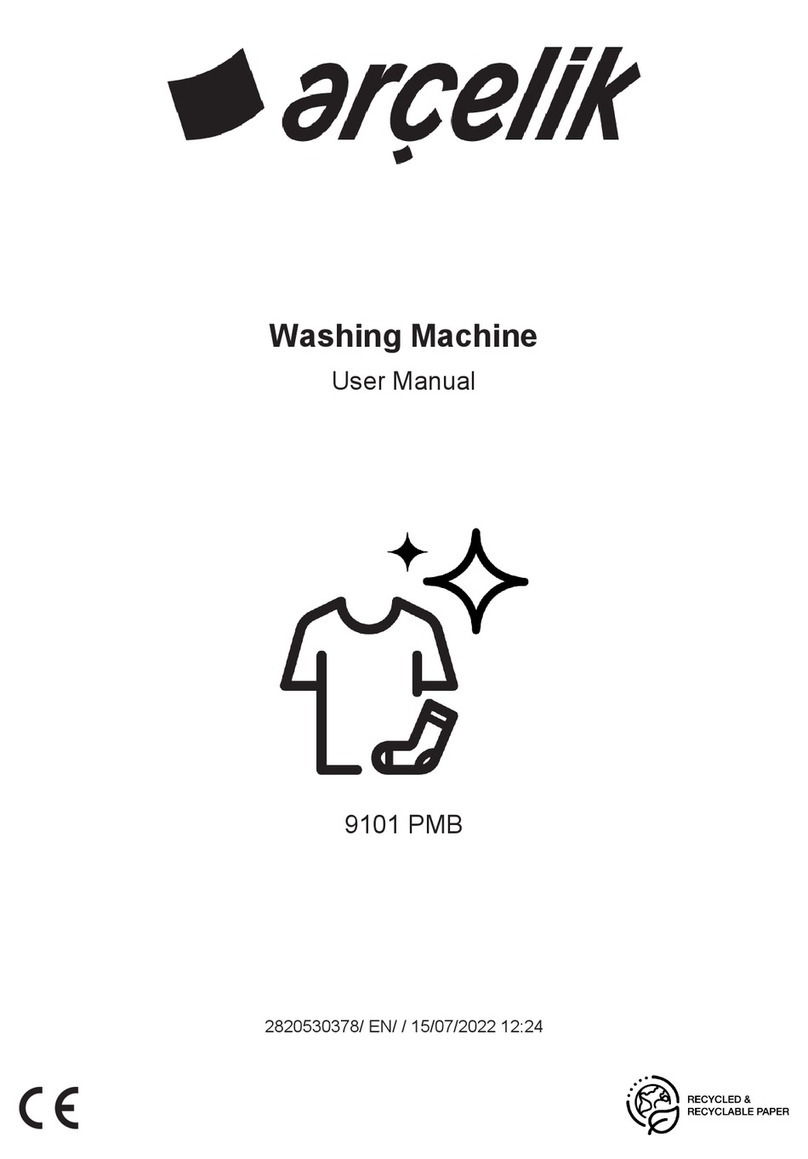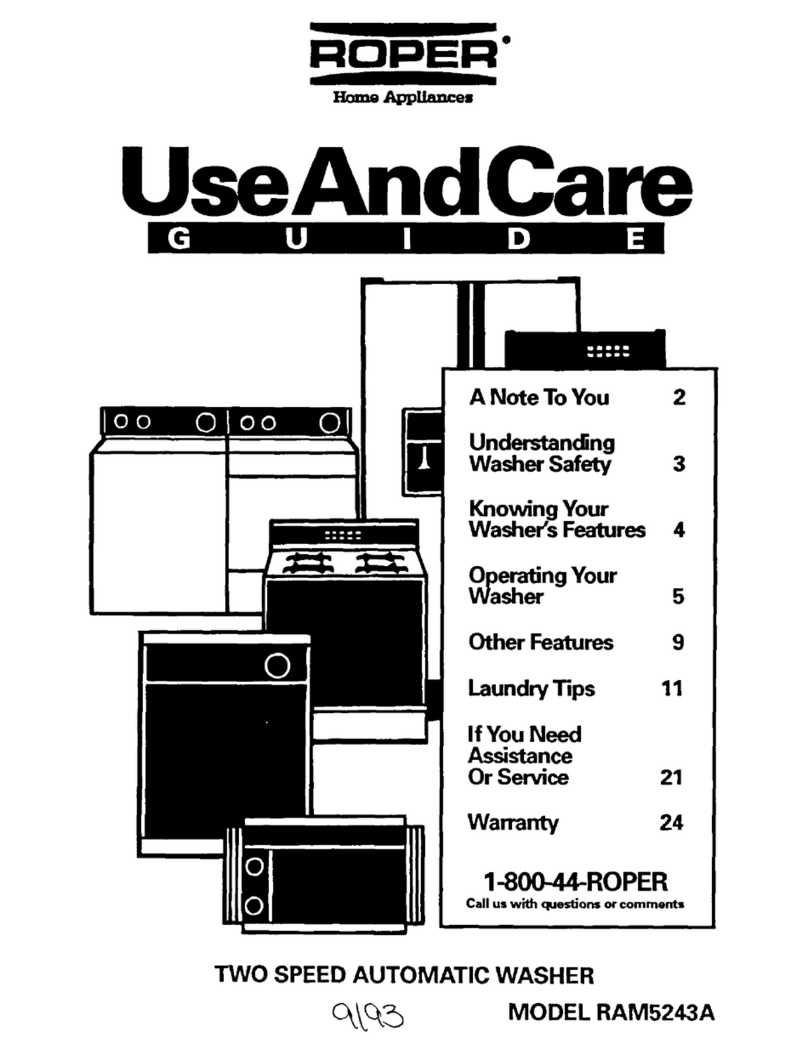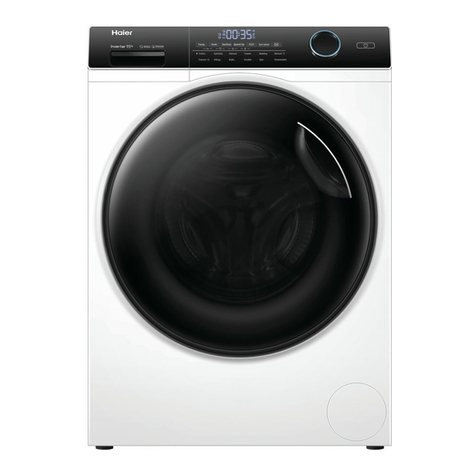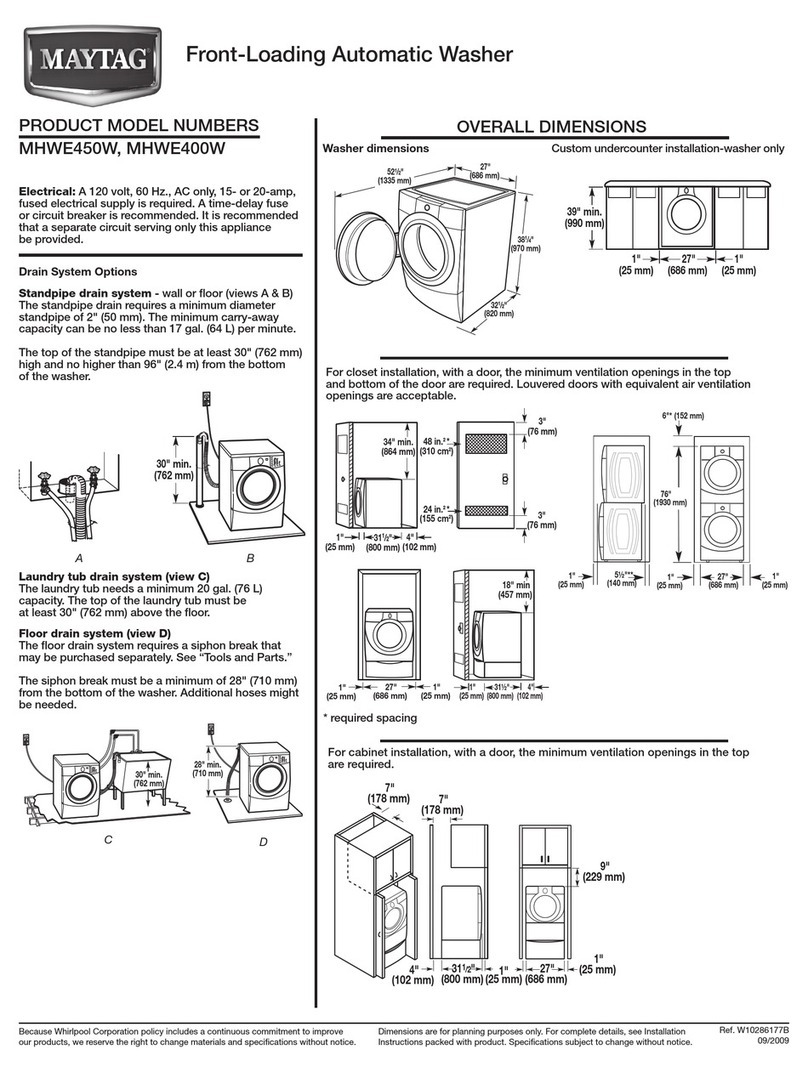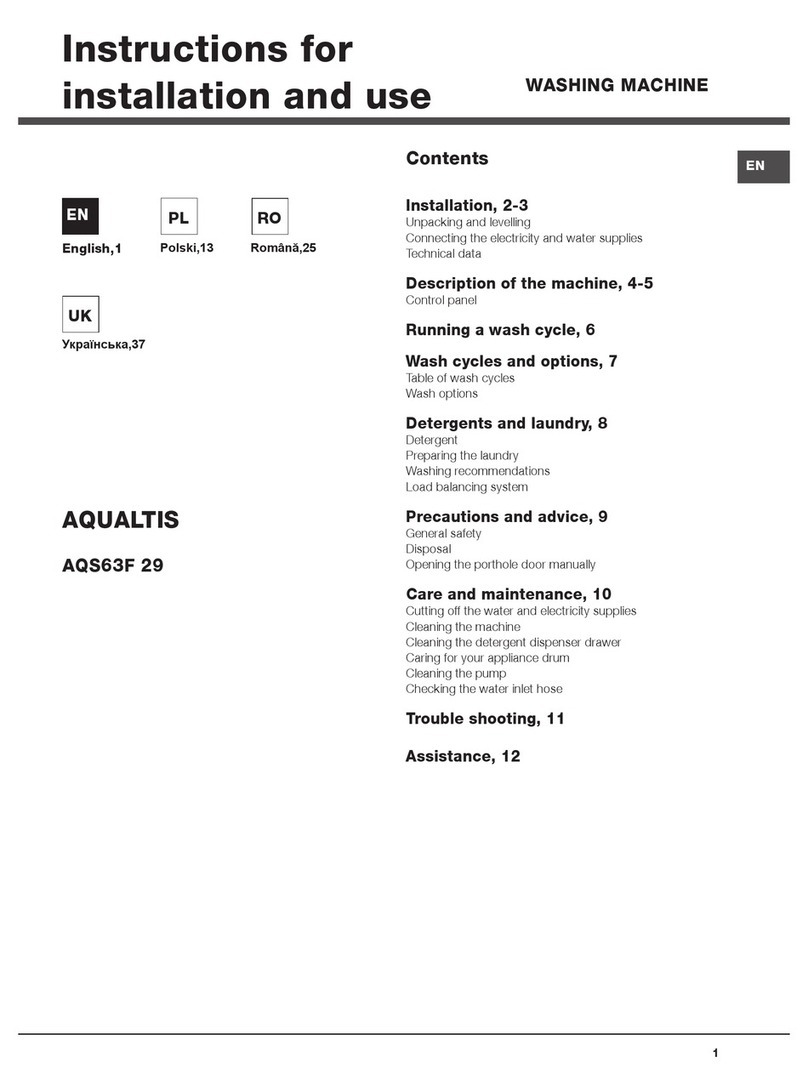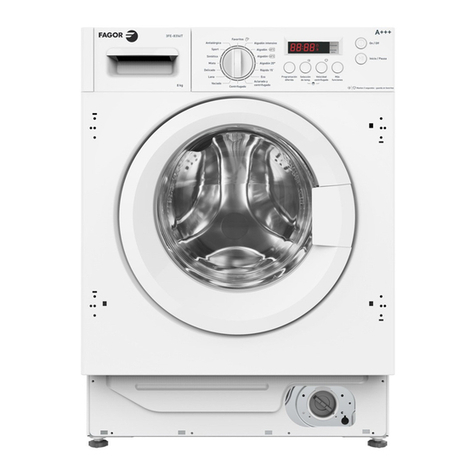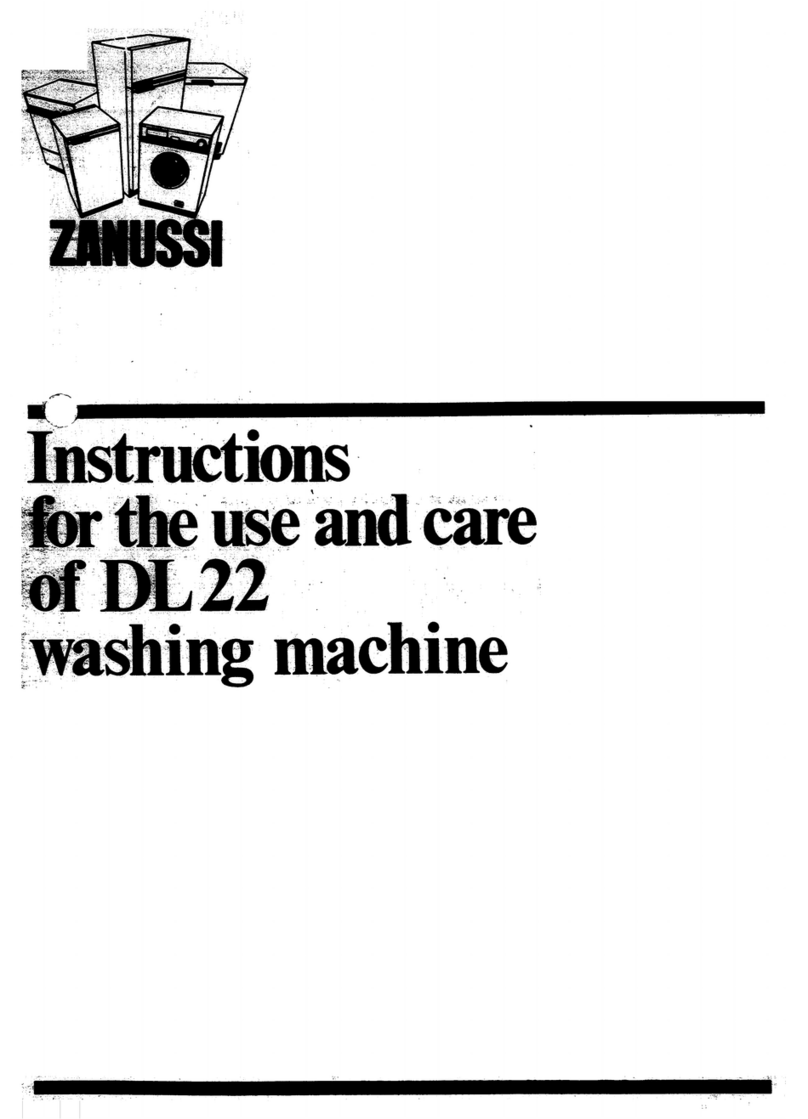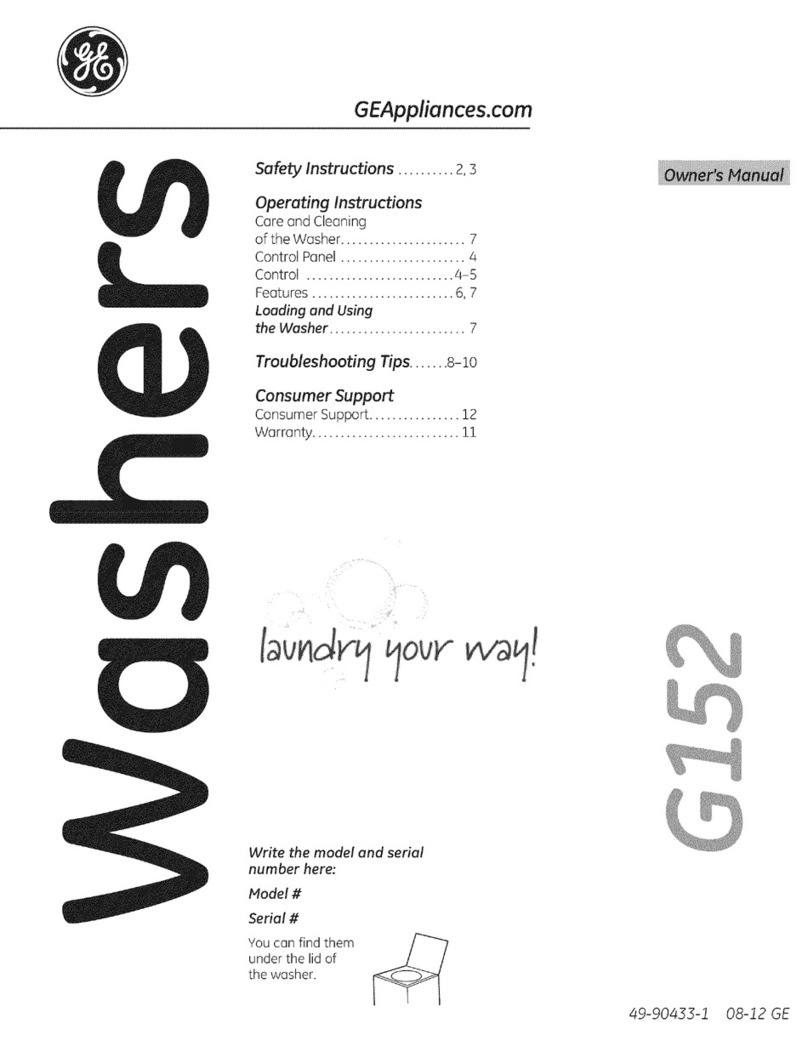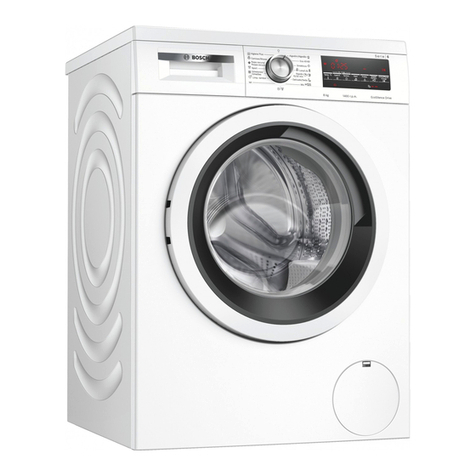Evoke EFL660W User manual

Thank you for choosing our Washing Machine.
It is essential to read this manual carefully before it is installed
and used for the first time.
Version number: V20210730
EFL660W

16
This washing machine conforms to current safety
requirements. Inappropriate use can, however, lead
to personal injury and damage to property.
To avoid the risk of accidents and damage to the
washing machine, please read this manual carefully
before using it for the first time. It contains
important information on its installation, safety, use
and maintenance.
Keep this manual in a safe place for future reference.
Contents
Safety notices
Parts and features
Installation
The functions of the control panel
How to use washer
Cleaning and maintenance
Troubleshooting guide
Technical parameters
Electric Diagram
PREFACE

To avoid the risk of personal injury or damage to the washing machine,
do not install it in place where it is damp and where it suffers from rainfall.
Do not install the washing machine in place where it suffers from the sun
directly, in which plastic or components will be damaged. It will be
shortened the life of your washing machine.
Do not install the washing machine in place where temperatures below
freezing may occur. Frozen hoses may burst or split. The reliability of the
electronic control unit may be impaired at temperatures below freezing
point.
Do not shoot the washing machine with water when you clean it.
Keep the washing machine away from fire or heat sources.
Before using the washing machine for the first time, make sure that the transit bolts
at the rear of the machine have been removed. During spinning, transit bolts which is still in place
may result in damage to both the machine and adjacent furniture or appliances.
Turn off the tap if the machine is to be left for any length of time (e.g. holiday), especially if there is
no floor drain (gully) in the immediate vicinity.
Take care to ensure that foreign objects (e.g. nails, pins, coins, paper clips) do not find their way
into the machine with the laundry. These may damage components of the machine (e.g. drum),
which in turn can result in damage to the laundry.
Do not wash water-repellent things(e.g. raincoats) with washing machine.
Only remove laundry from the washing machine once the drum has stopped turning. Reaching
into a moving drum is extremely dangerous and could result in injury.
Correct use
Safety with children
Keep children away from the washing machine at all times. To avoid
the risk of injury do not allow children to play on or near it or to play
with its controls. Supervise children whilst you are using it.
Older children may only use the washing machine if its operation has
been clearly explained to them and they are able to use it safely,
recognising the dangers of misuse.
For machines with a 'porthole' door, remember that the porthole glass
will be hot when washing at very high temperatures. Do not let children
touch it.
THIS WASHING MACHINE MUST BE EARTHED.
Before setting the washing machine, check it for any externally visible damage.
Do not install or use a damaged washing machine .
Before connceting the washing machine, ensure that the connection data on the
plate(voltage and current)match the electricity supply. if in any doubt,
consult a qualifiled electrician.
The electrical safety of this washing machine can only be
guaranteed when continuity is complete between it and an effective
earthing system which complies with current local and national
safety regulations. It is most important that this basic safety
requirement is present and regularly tested, and where there is any
doubt the household wiring system should be inspected by a
qualified electrician. The manufacturer cannot be held liable for the
consequences of an inadequate earthing system.
Unauthorized repairs could result in unforeseen dangers for the user, for which manufacturer can
not accept liability. Repairs should only be undertaken by an approved service technician.
Ensure current is not supplied to the machine until after maintenance of repair work has been
carried out.
If the connection cable is damaged or broken, it must only be replaced by an approved service
technician to protect the user from danger.
Faulty components must only be replaced by genuine manufacturer original spare parts. Only
when these parts are fitted the saftey standards of the machine can be guaranteed.
Do not connect the washing machine to the mains electricity supply
by an extension lead. Extension leads do not guarantee the required safety of the appliance.
Safety Notices
Read and understand thoroughly these safety instructions before
use. The items indicated here are very important safety precautions,
which must be followed. We cannot be held liable for damage caused
by non-compliance with the warning and safety instructions or
resulting from incorrect use or operation.
Cleaning and user maintenance shall not be made by children without supervision.
Children of less than 3 years should be kept away unless continuously supervised.
The new hose-sets supplied with the appliance are to be used and the old hose-
sets should not be reused.
WARNING
This appliance is not intended for use by persons (including children) with
reduced physical, sensory or mental capabilities, or lack of experience and
knowledge, unless they have been given supervision or instruction
concerning use of the appliance by a person responsible for their safety.
Children should be supervised to ensure that they do not play with the
appliance.
This appliance is intended to be used in household and similar applications
such as:
-staff kitchen areas in shops, offices and other working environments;
-farm houses;
-by clients in hotels, motels and other residential type environments;
-bed and breakfasts type environments;
-areas for communal use in blocks of flats or in launderettes.
For washing machines having ventilation openings on the base, the washing
machines cannot be washing on the carpet.

Unscrew the drain pump filter to let water run out when the
machine is not used for a long time.
The drawing of machine in the manual is only used for instruction.
It may be vary from the mode you buy.
Parts and Features Installation
Before Use Before Use
Backout packing
Remove all the packing(including the foam base)
or the vibration and noise may occur.
Dispose all the wrappage safety and keep them out
of the reach of children. Danger of suffocation!
It is normal that water drops appear on the packing
plastic bag and the door glass, which are resulted
from the water left in the tub for checking out.
Accessories
Make sure that you have received all of the items shown below.
Accessories Name Qty. Accessories Name Qty.
Inlet hose
transit bolts
caps
1
4
“U” piece 1
Manual 1
Removing transit bolts
Remove all the transit bolts at the back of the machine with tools.
Plug the holes with the transit bolts caps supplied.
Strong vibration, noise or failures may occur if
the transit bolts are not removed.
Keep the transit bolts for future transportation.
Whenever the machine is transported, the
transit bolts must be refitted.
Inlet vavle

Installation Use process
Installation
Installation place requirement
A concrete floor is the most suitable installation surface
for a washing machine, being far less prone to vibration
during the spin cycle than wooden floorboards or carpeted
surface.
The machine must be level and securely positioned. The
distance between the machine and wall must be more than
10 cm .
To avoid vibrations during spinning. the machine should not
be installed on soft floor coverings.
Level adjustment
The machine must stand perfectly level on all
four feet to ensure safe and proper operation.
Incorrect installation may cause vibrations
and noise and may cause the machine to
move about.
To do these when the machine is not level:
Using the spanner turn locknut in a clockwise
direction. Then turn locknuts together with
adjust feet to unscrew.
Hold adjust feet securely with a pipe wrench.
Turn locknut again using the spanner until it sits
firmly up against the housing.
Vibration and noise may occur if the locknuts do
not sit firmly up against the houses.
Drain hose connection
2. Connected securely to a standpipe
Firstly form a hook in the end of the drain hose using the “U” piece supplied.
Place the drain hose into your standpipe, which should have an internal diameter of approximately
30mm thus ensuring there is an air break between the drain hose and standpipe.
When discharging into a standpipe ensure that the top fo the standpipe is no more than 90cm and
no less than 60cm above floor level.
Water inlet connection
Connect the inlet hose supplied with the machine to a tap with a 3/4" thread.
Do not use previously employed hoses.
Installation should comply with local water authority and building regulations ‘ requirements.
When there is a inlet valve at the back of the machine, it must be connected to a cold water
supply. If there are two inlet valve, one is connected to a cold water supply and the other
is connected to a hot water supply. Follow the indication of the picture below to complete the
connection.
inlet valve for cold water
inlet hose for cold water with a white nut
Use process
1.Direct into a sink
If the outlet spigot has not been used before, remove any blanking plug that may be in place.
Push the drain hose onto the spigot and secure with a clip if required, ensure a loop is formed
in the drain hose to prevent waste from the sink entering the washing machine.
If required, the drain hose can be extended to a length of 4 m.

The functions of the control panel The functions of the control panel
Options and functions for programs
Use process Use process
For your safety, please don’t press the “Power” button and get clothes while the
machine is running. Because the temperature of water may be high and it may scald
you. The door lock will open automatically at the end of a wash cycle while the tem-
perature of the drum is cool down.
4.
Turn this knob clockwise or anticlockwise to select the required wash program. Once the
“Start/Pause” button is pressed and the machine is running, the program can not be changed.
The details of programs are in Form 1 on page 8.
(Note: Be sure to switch the machine off at the end of a wash cycle .
2.
Press this button to start or pause a wash cycle. The LED of “Start/Pause”flickers when the
machine is in standy mode or pauses,and it is lighted when running. The running time above is for the default programs, which is only for reference,
and it may be different because of different laundries, weights and washing
temperature.
Press this button to turn the machine on or off.
1. Power
Press this button and select a required wash temperature.The details are on page 8.
When all the lights of temperature are off,the wash temperature is “Cold”.
3. Temp
4
Program Max Temp(℃)
20℃
Anti-Allergy
Quick
Spin
Intensive
Mixed
Wool
Max.Load(kg) Max Spin speed(rpm)
6
3.5
2
2
4
20
90
20
60
Time
57
107
11
131
18
50
63
185
Eco 40-60 – –
60
800
1200
1200
1200
800
800
600
800
6
6
6
– –
Cold

1. Open the drawer and add adequate detergent into main wash compartment marked “ ” or “ ”.
2. Add the fabric softener into compartment marked “ ” or “ ” .
Do not exceed the maximum level mark.
3. Close the drawer.
How to use washer How to use washer
Use process Use process
1. Sort the laundry by colour and by care label. Most garments have a
textile care label in the collar or side seam.
2. Make sure all the pockets are empty, Foreign objects (e.g. nails, coins,
paper clips, etc.) can cause damage to garments and components in
the machine.
3. Close any zips, fasten hooks and eyes etc before washing.
4. Dark textiles often contain excess dye and should be washed separately
several times before being included in a mixed load. Always wash whites
and coloureds separately.
5. Badly soiled areas, stains etc. should be pre-treated with liquid detergent,
stain removers etc.
6. Turn over the clothes which pill easily and is with woolen surface before
putting them into the machine.
Unfold the laundry and load loosely in the drum. Mixing both large and small items gives better
wash results and also helps distribute the load evenly during spinning. The most efficient use of
energy and water is achieved when a full load is washed. However, do not overload as this causes
creases and reduces cleaning efficiency.
Make sure that no garments are nipped between the
door and the seal.
It can remove the water out which left in the tub because of manufacturer’s checking out.
Before washing clothes for the first time, you must run a complete cycle without clothes.
To do these:
1.Connect the power and turn on the tap.
2.Press the “Power” button ,then turn the knob to position “Cotton ”.
3.Press “Start/Pause”.
Washing preparation
1.Connect the inlet hoses well and turn on the tap.
2.After making sure the power socket is grounded reliably, insert the power plug into the power
socket.
3.Place the drain hose well.
Preparation of clothes
Put clothes into the washer
Using the detergent drawer
The right amount to dispenser will depend on the following:
The quantity of laundry
The soiling level of the laundry
- Lightly soiled
No visible dirt or stains. Possibly slight body odour.
- Normally soiled
Visibly dirty and/or just a few slight stains.
- Heavily soiled
Visible dirt and stains and/or dried on soiling.
The water hardness level.
It is recommended to use low foaming powder for all washing temperature programs.
Washing steps
1.Turn on the water tap, and connect the power.
2.Open the door, and put the cloth into the drum one by one.
3.Close the door, and put suitable amount of detergent and fabric softener into the dispenser, then
close the drawer.
4.Press the “Power” button,and choose a programme you need by turning the knob .
5.Press the “Temp” button and select a wash temperature.
6.Press “ Start/Pause” button to start the washing machine.
7.When the cycle is finished, there is a warning tone sounds.
When washing cycle is finished, the machine will change into standby mode.
And the power will be off after 10 minutes without any control on the control panel.
Main wash compartment
Fabric softener compartment
Pre-wash compartment

When the machine is started , the door lock is locked though you press the “Start/Pause”button.
Turn the knob to position “ ” the door lock is unlocked in two minutes.
When the temperature inside the durm is above 60℃, the door lock is locked.
When the water is above a certain level, the door lock is locked.
When the washing cycle is finished, the door lock is unlocked after two minutes.
How to use washer Use process
Washing programme chart
The machine is fitted with a balance control device, which ensures the machine is stable
during the spin. To protect the machine, it will cut in if the laundry is not evenly distributed
in the drum. The laundry is redistributed by reverse rotation of the drum. This may happen
several times before the unbalance disappears and normal spinning can resume. If, after
15 minutes, the laundry is still not evenly distributed in the drum, the machine will not spin.
In this case, redistributed the load manually and reselect the spin programme.
Door lock
Use process
Cleaning and Maintenance
Important:
Do not try to open the door when the washing cycle is not finished or power supply is cut off
during the washing cycle, because the temperature may be high and you may be scalded.
Disconnect the machine from the mains electricity supply and withdraw the plug from
the socket before cleaning the machine.
The washing machine must not be hosed down.
Cleaning the exterior
Clean the exterior with a mild non-abrasive cleaning agent or soap and water using a well wrung-out
cloth. Wipe dry with a soft cloth.
Do not use solvents, abrasive cleaners, glass cleaners or all-purpose cleaning agents.
These might damage plastic surfaces and other components because of the chemicals
they contain.
The washing drum
Clean the drum every 3 months by using the “Anti-Allergy” programme.
Cleaning the drawer
Remove detergent residues regularly. Clear the drawer following these:
Pull out the drawer until a resistance is felt. Press down the release catch and at the same time
pull the drawer right out of the machine.
Remove the siphon from compartment and clean it.
Clean the dispenser using a brush and warm water.
Washing symbol Fabric
Programme
Cottons, linens or cotton mix fabrics, e.g. table linen, towelling,
underwear, T-shirts etc.
Cottons, linens or cotton mix fabrics, e.g. table linen, towelling,
underwear, T-shirts etc.
Machine-washable or hand-washable wool or wool blend fabrics.
If the care label does not specify a temperature, wash using the
cold setting. Also suitable for hand-washable silks.
Reduce the spin speed.
Small loads of items which require freshening up and which can
be washed in a Cotton programme.
Quick
Separate spin for cotton and linen itemsSpin
Wool
Eco 40-60
Intensive

Cleaning and Maintenance Troubleshooting guide
1.
it is secure.
Check the connection and ensure
2. Change the temperature sensor.
1. The connection between the
temperature sensor and wire is
not secure.
2. The temperature sensor is damaged.
1. Check the connection and ensure
it is secure.
2. Change the heater.
1. The connection between the
heater and wire is not secure.
2. The heater is damaged.
1. Check the connection and ensure
it is secure.
2. Check if the machine is overloaded.
Switch off the machine, and retry
when the motor becomes cool.
3. Change the motor.
1. The connection between the
motor and wire is not secure.
2. The motor is protected because
of over-heat.
3. The motor is damaged.
1. Change the water inlet.
2. Check the connection and ensure
it is secure.
3. Change the water sensor.
1. The water inlet valve is damaged.
2. The connection between the
water sensor and wire is not
secure.
3. The water sensor is damaged.
Possible Cause
The water of
machine fills
overtime.
There is a Door
lock alarm.
1. Water tap is not open.
2. Drain hose is put down.
3. Water inlet valve is damaged.
1. Open the water tap.
2. Hook up the hose.
3. Change the water inlet valve.
Problem Error Code
The machine
drains overtime.
Water overflows
the machine.
/ Water sensor
works abnormal.
The motor does
not work.
There is a
heater fault.
There is a
temperature
sensor fault.
1. Check the drain hose.
2. Clean the filter.
3. Check the drainage system
and clean it.
1. The drain hose is squashed
or kinked.
2. The drain pump filter is block.
3. The drainage system pipes are
blocked.
1. Lock the door well.
2. Put the garment into the drum.
3. Change the door lock.
1. The door is not locked well.
2. Garments is caught between the
door and seal.
3. Door lock is damaged.
Difficult explanation
After use
“Spin” LED
flickers.
“Rinse” LED
flickers.
“Spin”and“Rinse”
LEDs flickers.
“Wash”LED
flickers.
“Wash”and
“Spin”
LEDs flickers.
“Wash”and
“Rinse”
LED flickers.
“Wash”,“Rinse”
and “Spin” LEDs
flickers.
Use pointed nose pliers to withdraw the plastic filter. Clean, put
back and secure. These filter should be checked every 6 months
or so, or more often if there are frequent interruptions to the water
supply.
Cleaning the drawer housing
Use a bottle brush to remove detergent residues inside the
drawer housing.
The filter must be put back in place after cleaning.
Important:
If the machine is exposed to temperatures below 0°C, certain precautions
should be taken.
1. Turn off the water tap.
2. Unscrew the inlet hose.
3. Unhook the drain hose from the rear support and position the end of this hose and that of
the inlet hose in a bowl. Run the spin programme.
4. Disconnect the appliance.
5. Screw the inlet hose and reposition the drain hose.
6. When you intend to start the machine up again, make sure that the room temperature is
above 0°C.
1. Disconnect the machine from
the mains electricity supply and
open the lower cover with a
screwdriver.
2. Place a container under
the pump.
Unscrew and remove the filter.
3. Clean the filter carefully.
Cleaning the water inlet filter
Cleaning the drain pump filter
The filter should be cleaned every 2 months or when there is
fault that the “Rinse”and “Spin” LEDS flicker.

Technical Parameters
Note:
Data can vary from the nominal values given depending on water pressure, water
hardness, water inlet temperate, room temperature, type and volume of load,
fluctuations in the electricity supply and any extra options seleceted.
Appendix Appendix
Energy-efficient test program emtrance guide:
Choose the program “Intensive”,set the washing temperature to “ ” 60°C
Environmental Protection
Power
Rated Power
Water Pressure
220-240V~;50Hz
2100W
0.02-0.8Mpa
Net Weight /Gross Weight
Outer dimension(WxDxH)mm
58kg/62kg
595x545x845
Power
Model EFL660W
This symbol on the product, or in its packaging. indicates that this product may not be
treated as household waste. Instead, it should be taken to the appropriate waste
collection point for the recycling of electrical and electronic equipment, By ensuring this
product is disposed of correctly. you will help prevent potential negative consequences
for the environment and human health, which could otherwise be caused by the
inappropriate waste handing of this product, For more detailed information about the
recycling of this product, please contact your local council, your household waste
disposal service, or the shop where you purchased the product.

Table of contents

